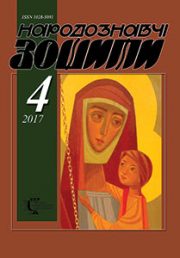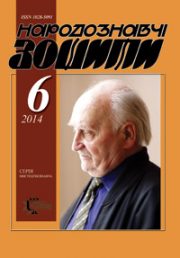The Ethnology Notebooks. 2023. № 2 (170), 314—323
UDK001-044.247:504.062(477:292.452)
DOI https://doi.org/10.15407/nz2023.02.314
INTEGRATION OF NATURAL SCIENCES AND SOCIAL AND HUMANITARIAN FIELDS OF SCIENCE ON THE EXAMPLE OF TRADITIONAL NATURE MANAGEMENT RESEARCH OF MOUNTAINOUS AREAS
BOYKO Ihor
- ORCID ID: https://orcid.org/0000-0002-3828-1835
- Candidate of Historical Sciences, Doctoral Student,
- Institute of Ethnology of the National Academy of Sciences of Ukraine,
- Prospekt Svoboda, 15, 79000, Lviv, Ukraine,
- Contacts: е-mail: ihor.o.bojko@gmail.com
Abstract. The relevance of the article is due to the fact that it is actually impossible to investigate traditional nature management using the methods of the narrowly specialized disciplines. Integration allows solving a large number of scientific questions, most of the «mysteries» of the socio-humanitarian sphere are explained by the laws and rules discovered in the natural and basic sciences. The mapped results of socio-cultural anthropology studies in the study of nature use can serve as an argument for one or another concept, scheme of geologists, geomorphologists, physical geographers, geobotanists, etc.
Interdisciplinary projects with the participation of scientists from various scientific fields are very fruitful, however, even there representatives of the social and humanitarian sphere should first integrate their research to improve the constructive work of the projects.
The completion of the integration approach in exploration of nature management of mountainous areas is the study of cultural and natural landscapes. One of the most important are pastoral landscapes (polonyna and glades), which arose or radically changed and expanded during the colonization of the territory and its subsequent use. The disappearance of these niches will fundamentally change the external appearance of the Carpathians, their attractiveness, natural and humanitarian potential, biodiversity; and therefore, the study of cultural-natural landscapes, the assessment of their «health», the proposal for «treatment» or restoration are of paramount importance both at the regional and the world level.
Scientific integration occurs in three ways: a) penetration of research methods and terminology from one discipline to others; b) development of a common approach and methodology in studying and processing material; c) creation of interdisciplinary sciences. The author shares his scientific experience in implementing all three ways of integration.
The subject of the article are the methods of integration of natural science and socio-humanitarian branches of science, and the object is the research of the natural science and socio-humanitarian branches of science of the traditional nature use of mountain areas.
The purpose of the article: to find out the level and possibilities of integration of natural science and socio-humanitarian fields in the study of traditional nature management of mountain areas on the example of own research.
Keywords: scientific integration, nature management, landscapes, Carpathians, Alen’s rule, adaptive evolution.
Received 25.02.2023
REFERENCES
- Tsokur, O.S. (Ed.). Outlines of lectures from the course «Methodology of Scientific Research and Organization of Science». Topic 1: concept, content and functions of science. Retrieved from:http://onu.edu.ua/pub/bank/userfiles/files/rgf/ped/011-mag-conspect-ped.pdf (Last accessed: 11.10.2022) [in Ukrainian].
- Trokhymchuk, S.V. (1968). Changing landscapes of the Sanok–Turka Mountains in the Ukrainian Carpathians during historical time. Dissertation for the degree of Candidate of Geographical Sciences. Lviv [in Ukrainian].
- Mukha, B. (2017). Topoclimates of Chornohora: monograph. Lviv: Ivan Franko National University of Lviv Press [in Ukrainian].
- Sobala, M. (2020). Mountain meadows and glades of the Carpathians — type or element of landscape? The problem of delimitation and typology of pasture landscapes. Sustainability (Vol. 12 (9). 3707. DOI: 10.3390/su12093707. Retrieved from: https://www.mdpi.com/search?authors=sobala&journal=sustainability&volume=12&issue=9 (Last accessed: 14.05.2022).
- Sobala, M. (2014). Pasture Landscapes in Poland and Europe — selected types, examples and conservation methods. Dissertations of cultural landscape commission (Issue 25, pp. 81—98) [іn Polish].
- Kopczynska-Jaworska, B. (1967). Economic and social relations in the traditional culture of the northern Carpathians. Lodz [іn Polish].
- Boiko, I. (2021). Geographical, cultural and ecological analysis of traditional mounain meadowsfield farms (salashes) in the Low Tatras. Human geography and cartography: scientific heritage and modern ukrainian studies Proceedings of All-Ukrainian scientific online seminar with the participation of foreign scientists, dedicated to the 120th anniversary of the birth of Professor Volodymyr Kubiyovych (1900—1985) (Ukraine, Lviv, December 17, 2020) (Pp. 284—290). Lviv: Prostir-M [in Ukrainian].
- Boiko, I., & Lach, J. (2016). Adaptive strategies of traditional seasonal construction in glades and pastures in the northern Carpathians (end of the 19th — first half of the 20th century). Materials for Ukrainian ethnology (Vol. 15, pp. 47—56) [in Ukrainian].
- Allen’s Rule. Retrieved from: https://uk.wikipedia.org/wiki/%D0%9F%D1%80%D0%B0%D0%B2%D0%B8%D0%BB%D0%BE_%D0%90%D0 %BB%D0%BB%D0%B5%D0%BD%D0%B0 (Last accessed: 11.15.2022).
- Bergman’s rule. Retrieved from: https://uk.wikipedia.org/wiki/%D0%9F%D1%80%D0%B0%D0%B2%D0%B8%D0%BB%D0%BE_%D0%91%D0%B5 %D1%80%D0%B3%D0%BC%D0%B0%D0%BD%D0%B0 (Last accessed: 11.15.2022).
- Boiko, I. (2021). Constructive features of flourson traditional field farms (salashes) in westernand ukrainian part of Eastern Carpathians (ecological and anthropological analysis). Human geography and cartography: scientific heritage and modern ukrainian studies Proceedings of All-Ukrainian scientific online seminar with the participation of foreign scientists, dedicated to the 120th anniversary of the birth of Professor Volodymyr Kubiyovych (1900—1985) (Ukraine, Lviv, December 17, 2020) (Pp. 275—284). Lviv: Prostir-M [in Ukrainian].
- Boiko, I., & Lach, J. (2021). Genesis, typology and distribution of log haylofts in the Western Carpathians in the first half of XX century. The ethnology notebooks, 6 (162), 1322—1334) [in Ukrainian].
- Boiko, I. (2018). Traditional construction on meadow huts in the Carpathians (end of the XIX th — first half of the XX th century) Collection of reports of the Second International Scientific and Practical Conference at the Museum of Arch. and life in Lviv named after Cl. Sheptytskyi. LMR; Museum of Folk Architecture and Life in Lviv named after Klymentii Sheptytskyi (Pp. 25—31) [in Ukrainian].
- Boiko, I. (2014). The structure of scythe, hay mowing, and ethnic-cultural adaptation of Ukrainians of the Carpathians (late XIX th — early XXI th centuries). Ethnographic review (Issue 3, pp. 177—185) [in Russian].
- Boiko, I., & Lozynsky, I. (2018). Distinctions and design features of the haystack in the Carpathians (end of XIX — the middle of XX century): cultural and environmental analysis. Scientific notes of Ternopil Volodymyr Hnatiuk National Pedagogical University. Series: History (Vol. 2, Issue 2, pp. 38—49). Ternopil: Department of TNPU named after V. Hnatyuk [in Ukrainian].
- Boiko, I. (2018). Cattle-sheds on individual pastures in the Carpathian Mountains: an ecological aspect (end of the XIX th — first half of the XX th centuries). Fortress: a collection of the reserve «Tustan» (Vol. 3, pp. 331—353). Lviv: Prostir-M [in Ukrainian].
- Boiko, I., & Lach, J., (2020). Glade farming as a product and a factor in the formation of landscape (using the example of the Boikivshchyna. Dissertations of cultural landscape commission (Vol. 43 (1), pp. 73—96).
- Boyko, I., & Lach, J. (2021). Traditional seasonal construction on lands of сomplex use in Boykivshchyna (first half of the XX century) The ethnology notebooks, 5 (161), 1063—1077) [in Ukrainian].
- Traditional construction in Boykivshchyna: cultural and ecological aspect. Retrieved from: https://www.academia.edu/90830879/%D0%A2%D1%80%D0%B0%D0%B4%D0%B8%D1%86%D1%96%D0%B9%D0%BD%D0%B5_%D0%B1%D1%83%D0%B4%D1%96%D0%B2%D0%BD%D0%B8%D1%86%D1%82%D0%B2%D0%BE_%D0%BD%D0%B0_%D0%91%D0%BE%D0%B9%D0%BA%D1%96%D0%B2%D1%89%D0%B8%D0%BD%D1%96_%D0%BA%D1%83%D0%BB%D1%8C%D1%82%D1%83%D1%80%D0%BD%D0%BE_%D0%B5%D0%BA%D0%BE%D0%BB%D0%BE%D0%B3%D1%96%D1%87%D0%BD%D0%B8%D0%B9_%D0%B0%D1%81%D0%BF%D0%B5%D0%BA%D1%82 (Last accessed: 19.11.2022).
- Boiko, I. (2016). Boikos’ traditional plow (an attempt of cross-cultural analysis). The ethnology notebooks, 4, 826—838) [in Ukrainian].
- Boiko, I.A. (2012). Anthropogeographical studies of the Ukrainian Carpathians and prospects for the synthesis of geographical and ethnographic methods of work. Ethnos and habitat (Vol. 3, pp. 199—230) [in Russian].
- Slyvka, R.O. Geomorphology of the WatershedVerkhovyna Carpathians. Lviv: Publishing Center of LNU named after I. Franka [in Ukrainian].
- Boiko, I. (2013). Spatially-agricultural specific of Boykivschyna landscapes (the end of XVIII century). Visnyk of the Lviv University. Series Geography (Vol. 41, pp. 38—49) [in Ukrainian].
- Melnyk, A. (1999). Ukrainian Carpathians: Ecological Land scape Studies. Lviv [in Ukrainian].
- Boiko, I. (2017). The Impact of the Resource Base and the Chosen System of Resettlement and Environmental Management on Construction Features on Polonine Building in Hutsul Villages of Ruskavo-Bilotysenskyy Watershed (XX c.). History of Ukrainian Geography (Vol. 35, pp. 63—71). Ternopil [in Ukrainian].
- Bojko, I. (2021). Features of the cultural and natural landscapes of Lemkivshchyna, Boykivshchyna and Hutsulshchyna. Human geography and cartography: scientific heritage and modern ukrainian studies Proceedings of All-Ukrainian scientific online seminar with the participation of foreign scientists, dedicated to the 120th anniversary of the birth of Professor Volodymyr Kubiyovych (1900—1985) (Ukraine, Lviv, December 17, 2020) (Pp. 263—274). Lviv: Prostir-M [in Ukrainian].
- Lach, J., & Boiko, I. (2019). Agro-shepherd buildings as a distinguishing feature of research on the typology and genesis of pastoral landscapes of the Polish-Ukrainian part of the outer Carpathians. TEKA of the Commission of Polish-Ukrainian Cultural Associations (Vol. 6 (13) [іn Polish].
- Lach, J., & Boiko, I. (2022). Protecting the Identity of Sheep-Farming Landscapes in the Outer Carpathians: A Typology, Delimitation and Interpretation. Landscape Journal (Vol. 41 (2), pp. 39—58).






